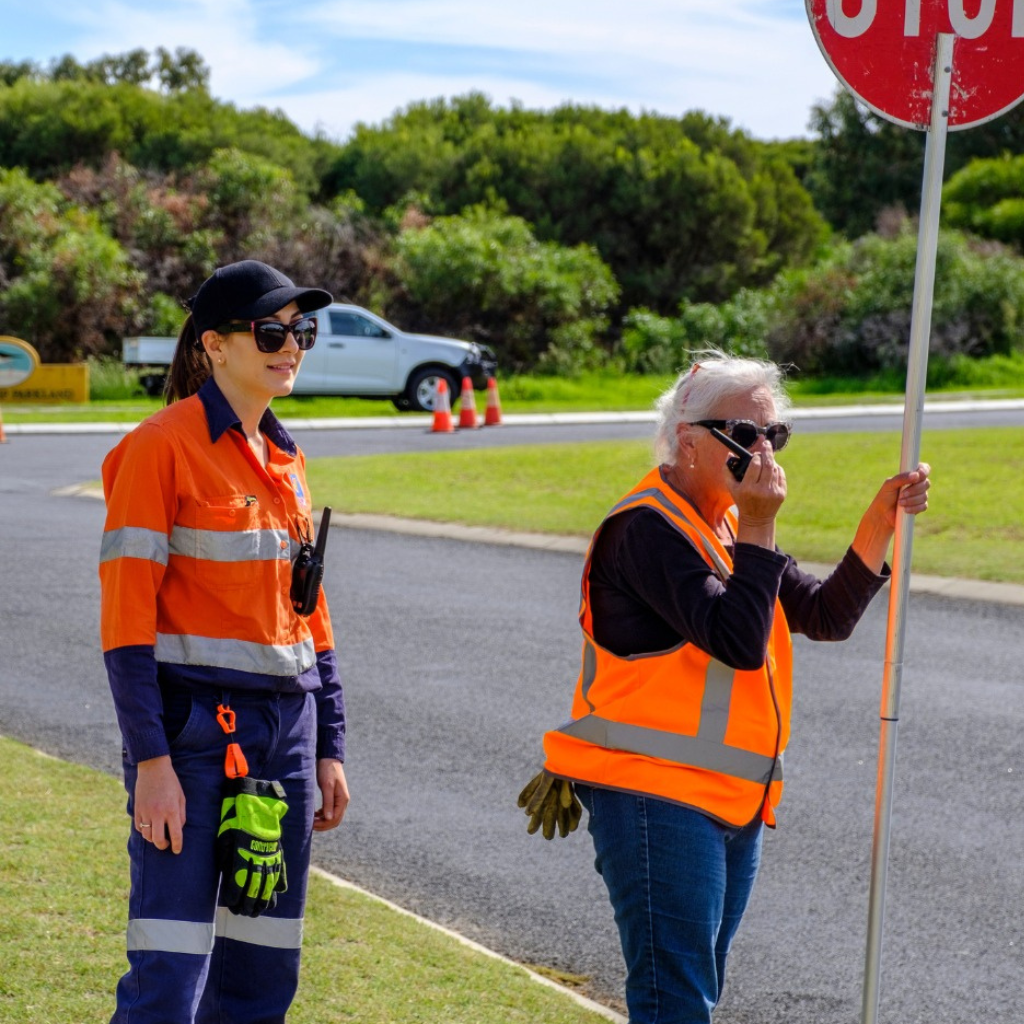Do you design, review or implement Traffic Management Plans? If so… read on.
We want you to ask yourself these questions:
- Do your TMPs comply with the Main Roads WA mandated templates?
- Are your TMPs being reviewed by a second independent person?
- Are Main Roads WA checklists being used in the design of your TMP?
- Are your risk assessments comprehensive, with detailed control measures that are justified?
- Is your Traffic Management provider / designer supplying you with quality and compliant TMPs?
- Have the Traffic Guidance Schemes been assessed as ‘site suitable’?
If you answered NO to any of the above – that’s okay! Not everyone is perfect and that’s where AusQ Training want to step in to help YOU!
We’re going to cover the most common design errors, tips on what you can implement to avoid these and provide you with tools and resources to advance & strengthen the quality of your TMPs.
Use these 11 strategies and techniques to improve your TMP (and compliance!)
1. Quality Assurance
You know the old saying – double check to prevent a wreck!
Always ensure you are using a two-step review process in the design of your Traffic Management Plan (TMP). At the conclusion of any TMP design, it should then be reviewed by a secondary person and ideally someone who is independent and doesn’t have any involvement therefore, giving you a fresh pair of eyes!
A suitability check is a check of the traffic management plan to ensure it addresses the specified requirements of the works, all types of traffic and the road environment. This includes a check of compliance with standards and the identification and mitigation of all site specific and operational risks.
2. Comprehensive Checklist
TMPs provide roadworks sites with a means of planning and implementing how road users will be affected for the duration of the works. A TMP is a legal and professional document therefore, should be carefully designed and thoroughly checked prior to release for use!
Main Roads WA have a mandated TMP Authorisation Checklist – The checklist details the minimum review local governments and other bodies with an Instrument of Authorisation should undertake before authorising traffic management on their network. This tool is intended for local government and other authorised bodies to use, however it is recommended TMP designers and/or reviewers to also use this prior to submitting seeking authorisation. The use of this checklist will save time and identify all items are covered to ensure authorisations are not delayed.
3. Main Roads WA TMP Template
Any party undertaking work on a road shall prepare a Traffic Management Plan (TMP) that adequately provides for the safety of workers and road users while maintaining an adequate level of service to road users.
To ensure a consistent approach is taken when developing a TMP Main Roads WA has a range of mandated TMP templates that must be used as a minimum.
These TMP templates shall be used as a basis for the development of the plan, either roadworks or events. Any section headings that are not applicable to the TMP being developed shall be kept in the document and noted as not applicable (with the intent of keeping the TMP section numbers the same throughout all TMPs (Traffic Management Plans)). Addition TMP information may be added at the end of the last section.
4. Works Methodology & Staging
Too often communication that occurs between the Project Owner and the Traffic Planner is second hand. This results in inadequate consideration of the actual collaborative planning for both workers and traffic management crew.
When there are insufficient details provided about the project scope it can create many problems, such as missing or inadequate Traffic Guidance Schemes (TGSs) for the work activity, unclear implementation instructions for the traffic crew, poor risk assessment missing elements exposing workers to further risk, delays to obtaining TMP approvals and more.
How do you improve this?
- Organise the Traffic Planner to meet up with the Project Manager on-site to view and discuss the project. This ensures everyone has a clear understanding (and details are not second hand). By doing this it removes a lot of unnecessary second guessing;
- Ensure the TMP designer has obtained and understood the scope and any specifications. Clearly show and outline each work stage to ensure there is temporary traffic management that matches each stage needs;
- Increase ALL communication, get involved – consider stakeholder reviews before, during and after the TMP design process.
5. Poorly Managed Risk Management
Management of risk control is primary to a compliant Traffic Management Plan. This involves the identification and analysis of all risks likely to arise during works on roads including during the setting up, operating, changing and ultimate dismantling of traffic guidance schemes, followed by the determination of appropriate measures to mitigate those risks. The process is applicable at all levels of planning and operation.
Traffic Management Planners can’t just assume the speed reduction is enough and it will mitigate the risk. Motorist non-compliance is inevitable so what other controls are being put in place?
When structuring a risk assessment TMP designers need to consider.
- Who or what is involved?
- What hazard is identified?
- What could cause this to occur?
- What is the event that will occur?
6. External Review
As noted in point 1, at the conclusion of any TMP design, it should then be reviewed by a secondary person and ideally someone who is independent and doesn’t have any involvement therefore giving you a fresh pair of eyes! Often this is a co-worker within the same organisation.
In addition to the above, we also recommend to consider for selected projects (perhaps the more complex or long term projects) to engage an external person/organisation to undertake another final review. Whilst this is not a mandatory requirement, it is an additional quality assurance strategy that could be considered time to time, to ensure you have a completely independent review. This method could then provide your organisation with new ways to improve processes.
7. Roles and Responsibilities
The 5 W’s (and 1 H) need to be asked and identified within every TMP design.
Who, What, Where, When, Why AND How
People’s roles and responsibilities need to be clearly defined and outlined within the TMP.
If an audit is stated as required in the TMP, who is responsible for organising or completing? When will this person undertake this audit?
Is this person/s identified at TMP design stage, is this requirement communicated to those involved and organised in advance? This information needs to be included within the Traffic Management Plan.
8. Contingency Plan
A contingency plan is a plan for the “what if” scenarios.
Some points worth noting in your TMP would be contingencies for:
- Will the work require aftercare?
- Who is responsible for the site after hours and who can be contacted?
- When will the site and setup be checked? Who and how will this be monitored?
9. Implementation Strategy
When designing your TMP, stop to ask yourself
- Who will be implementing the TMP?
- Are they able to interpret the TMP? (is the information clear for any reader?)
- Do they have the knowledge, skills and resources required to implement adequately?
TIP – AGTTM Part 6 provides guidance to implementors of temporary traffic management at road worksites. This is typically done in accordance to the Traffic Guidance Scheme (TGS).
AGTTM Part 6 covers the principles of processes and responsibilities for field staff in the role of preparing for, implementing, monitoring, and removing temporary traffic management from site. Aspects covered in this Part for the implementation of temporary traffic management include:
- principles of implementation
- roles and responsibilities
- pre-shift activities
- pre-start activities
- installation of TGSs
- operation and monitoring of TGSs
- removal of TGSs
- unattended sites
10. Traffic Guidance Scheme Detail
A TGS is defined as ‘Site Suitable’ once a site visit or investigation of the site is conducted and it has been confirmed that the selected TGS is appropriate for use for the works at that site. All Generic TGS shall be confirmed as a Site Suitable TGS prior to commencement of works.
Location information needs to be added to the Generic TGS. Confirmation that a Generic TGS is site suitable shall be performed and signed off by a BWTM, WTM or AWTM, details shall be recorded in the daily diary.
11. Feedback
Seek feedback from your traffic crew about the Traffic Management Plan and ask if there were any parts of it that were unclear. Often this part isn’t done or done enough, those reading and interpreting the TMP are the most valuable source of feedback.
Ask the question – “If we were to implement this TMP again, what would you change or do different?”
The crew onsite will have the best insight and feedback relating to implementation and overall use of the traffic management plan.
Summary
We hope you enjoyed these 11 tips to improve your TMPs. Take the hassle out of worrying if your TMP is compliant and meets all requirements. We have a team of Traffic Planners who can design all types of TMPs from roadworks, events and non-complex or major complex planning. Request a quote.
Or perhaps you just want someone independent to come in and review your TMP and give you the peace of mind all areas are covered – we can help with that too!
Do you need training?
AusQ Training offer a range of courses to assist you in the traffic management or construction industry, in Perth, Bunbury and all over WA – to view our range of public training courses [click here] or view our calendar here.
Make a time to chat to one of our Customer Support Team members [here] to discuss your traffic management training needs.


